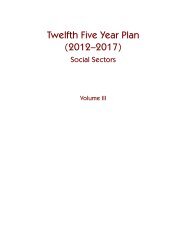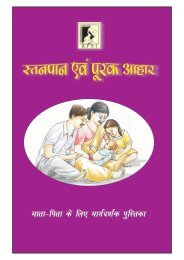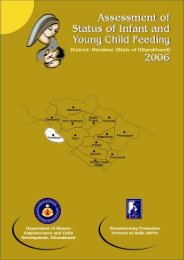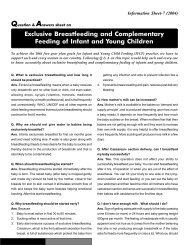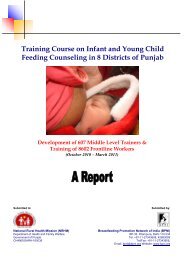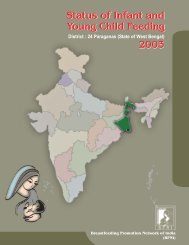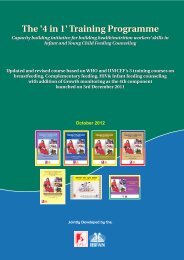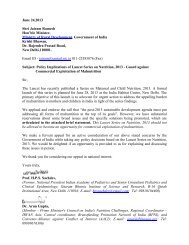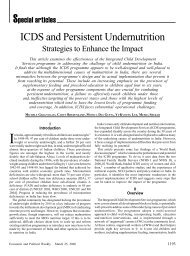1 - BPNI
1 - BPNI
1 - BPNI
Create successful ePaper yourself
Turn your PDF publications into a flip-book with our unique Google optimized e-Paper software.
AcronymsANMAWWsBFHI<strong>BPNI</strong>CDPOsDPODWCDEBFIMRIMS ActIYCFIECMPRsNFHSNGOsOBCSCSTTBAsUNICEFWHAWHOAuxiliary Nurse MidwivesAnganwadi WorkersBaby Friendly Hospital InitiativeBreastfeeding Promotion Network of IndiaChild Development Project OfficersDistrict Program officersDepartment of Women and Child DevelopmentExclusive BreastfeedingInfant Mortality RateThe Infant Milk Substitutes, Feeding Bottles and Infant Foods(Regulation of Production, Supply and Distribution) Act, 1992 asamended in 2003Infant and Young Child FeedingInformation, Education & CommunicationMonthly Progress ReportsNational Family Health SurveyNon Government OrganisationsOther Backward CastesSchedule CasteSchedule TribesTrained Birth AttendantsUnited Nations Children’s FundWorld Health AssemblyWorld Health OrganisationiStatus of Infant and Young Child Feeding in Kurukshetra, Haryana
District ProfileThe district has an area of 1682.53 Sq.Kms. constituting 3.8% of the total area of the State.Total area under cultivation is 168000 hect. Out of this, 147000 hect. is net irrigated area.Kurukshetra district lies between latitude 29o-52' to 30o- 12' and longitude 76o-26' to 77o-04'in the North Eastern part of Haryana State. The district headquarter is located at Kurukshetratown and is about 160 Kilometers North of Delhi, 39 Kilometers North of Karnal and 40Kilometers South of Ambala. It is at a distance of about 6 kilometer from Pipli an importantroad junction on the National Highway No.1 popularly called the Grand Trunk Road.Kurukshetra Railway Station, also called the Kurukshetra Junction, is located on main Delhi-Ambala Railway line. The other important towns of the district are Pehowa, Shahbad &Ladwa. The district consists of 419 villages.The climate of the district is of pronounced character i.e. very hot in Summer and markedlycold in winter. It is as high as 45 degree C in summer and as low as 3 degree C in winter.Kurukshetra is a place of great historical and religious importance, revered all over thecountry for its sacred associations. It was here that the battle of Mahabharta was fought andLord Krishna preached his Philosophy of "KARMA" as enshrined in the Holy Geeta to Arjunaat Jyotisar. In the very first verse of Bhagwat Gita, Kurukshetra is described asDHARAMKSHETRA i.e. field of righteousness. Mythologically, the name Kurukshetra appliedto a circuit of about 48 KOS or about 80 miles (128 Kms) which includes a large number ofholy places, temples and tanks connected with the ancient Indian traditions and theMahabharata War and Kururu, the pious ancestor of Kaurvas and PandavasAccording to census 1991, total population of the district is 669346. The population density is398 per Sq.Km. The sex ratio in this district is 879.Sr. no. Particulars No.1. Total Population (1991) 6,69,3462. Male 3,56,1813. Female 3,13,165iiiStatus of Infant and Young Child Feeding in Kurukshetra, Haryana
Executive SummaryThis survey on infant feeding practices in Kurukshetra, district of Haryana was assigned to<strong>BPNI</strong> by Department of Women & Child development, under improving Infant & Young ChildFeeding in Haryana, during the year 2005-06.Assessment of infant and young child feeding practices in the community is the first step toimprove the child nutrition and development. The survey helps in documenting the prevalentinfant and young child feeding practices and also give insight where actions are required toimprove the situation.The findings of this survey are documented under two heads quantitative and qualitative. Thequantitative findings describe the prevalent IYCF practices and qualitative ones describe thereasons behind such practices in Kurukshetra district of Haryana.Quantitative-The infant feeding practices were found sub-optimal at every indicator like early initiation ofbreastfeeding within 1 hr was found as low as 40%, Prelacteal feeding that is very harmful fornewborn, was highly prevalent (53%) and exclusive breastfeeding for 6 months was found46% in this district. Low percentage (41%) of exclusive breastfeeding in 4-6 months children isof serious concern.Qualitative-1. Prelacteal feeding is very much prevalent because the harmful effects of these are notinformed to mothers during pregnancy and families.2. Support and assistance at birth by health care providers was not available for earlyinitiation of Breastfeeding.3. Skilled-counseling on sufficiency of Exclusive breastfeeding to fulfill all needs of childrenfor first 6 months was not given to these mothers.4. Counseling on optimal Infant and Young Child feeding, at multiple opportunities, wasnot available to these families.Recommended strategies-• Family level interventions are necessary to ensure early start and exclusive breastfeedingfor this IYCF counseling must be delivered as “service’ in all child health programsthrough home visits/ multiple contacts and periodical monitoring of these servicesshould be done.• Create breastfeeding support centers lead by Lady Supervisor in her circle afterappropriate training is provided to them. They could in turn act as trainers of frontlineworkers.• Early intervention in the health facility by ensuring ten steps to successful breastfeedingunder Baby Friendly Hospital Initiative (BFHI).• Intensifying IEC activities on IYCF feeding counseling through print and electronicmedia, ensuring accuracy and in line with IMS Act.• Nutrition education should properly address the taboos and customs prevalent in thecommunities.1 Status of Infant and Young Child Feeding in Kurukshetra, Haryana
1. IntroductionThis report is a part of the survey on infant feeding practices in 4 districts of Haryana i.e.Jhajjar, Karnal, Kurukshetra and Panipat assigned to <strong>BPNI</strong> by Department of Women andChild Development, Haryana under improving Infant & Young Child Feeding in Haryana,during the year 2005-06.This is the documentation of the findings of the quantitative and qualitative study of infantfeeding practices for Kurukshetra district in Haryana.1. In Phase I, quantitative data (percentage early initiation, exclusive breastfeeding,complementary feeding, prelacteal feeding) was collected by interviewing mothers ofinfants between the ages of 0 - 12 months.2. During Phase II, qualitative data (barriers and opportunities for optimal infantfeeding practices) was collected through in-depth interviews of mothers, pregnantwomen, mothers-in-law, health workers and father-in-law/husband.The report provides not only the prevalent infant and young child feeding practices inKurukshetra, but also brings to light several reasons that help or hinder these practices. Thereport consists of a brief background, methodology, findings of the quantitative study in part-1, findings of qualitative study in part-2. Finally, it attempts to make recommendations forfuture action.Status of Infant and Young Child Feeding in Kurukshetra, Haryana 2
healthy growth. Optimal infant feeding also contributes to improved development outcomesand better active learning capacity in young children. The World Bank has produced acomprehensive report on the importance of improved nutrition on the reduction of poverty.Central to the report’s recommendations is the firm statement that steps to preventmalnutrition MUST occur during pregnancy and the first 2 years of life. 5Scientific evidence is available that breast milk alone is the ideal nourishment for infants forthe first six months of life, and their ’first immunization’. It contains all the nutrients,antibodies, hormones and antioxidants that an infant needs to thrive – the ‘nurture providedby nature’. It protects babies from diarrhoea and acute respiratory infections, stimulates theirimmune systems and thereby prevents and reduces malnutrition, morbidity and mortality ininfants and young children.Promotion of optimal infant and young child feeding practices is crucial for preventingmalnutrition & early growth faltering; reducing infant and neonatal mortality and forpromoting integrated early child development. Breastfeeding is a critical entry point forensuring progressive fulfillment of children’s rights to survival, growth and development tofull potential, without discrimination.Breastfeeding also creates a strong bond between the mother and the child, stimulatingdevelopment of all five senses of the child, providing emotional security and affection, with alifelong impact on psychosocial development. New research also indicates that it conferscognitive benefits, thereby enhancing brain development and learning readiness. Responsivecare and feeding is another way in which infants participate actively in their owndevelopment. The benefits of breastfeeding for maternal health, well-being andempowerment including those for birth spacing are also well established.National Plan of action for children, 2005 underline India’s commitment for childrenmanifested in several articles of the constitution dedicated to children. It also spells that therights of child articulated in the constitution of India and the CRC should work in synchronyto ensure all rights to all children. Building on these provisions and in recognition to India’scommitment to the Millenium development Goals and the World Fit for Children, the stateshall work to progressively extend these guarantees and protections to all children.India has become one of the first countries in the world to update its legislation to protect,promote and support breastfeeding, in harmony with the new Global Strategy for Infant andYoung Child Feeding. The enactment of the Infant Milk Substitutes, Feeding Bottles andInfant Foods (Regulation of Production, Supply and Distribution) Act, 1992 (as Amended in2003) is a major step forward in ensuring the best possible start in life for young children. ThisAct regulates marketing and supply of infant milk substitutes, feeding bottles and infantfoods. It mandates that all mothers be empowered so that their infants receive exclusivebreastfeeding for the first six months. Thereafter, they shall receive optimal complementaryfeeding, along with continued breastfeeding up to two years of age or beyond.In 2004, National Guidelines for Infant & Young Child Feeding was came into action these callfor concrete action plans on optimal Infant and Young Child Feeding and lists responsibilitiesof several stake holders5 World Bank. (2006). Repositioning Nutrition as Central to Development: A Strategy for Large-Scale Action .http://siteresources.worldbank.org/NUTRITION/Resources/281846-1131636806329/NutritionStrategy.pdfStatus of Infant and Young Child Feeding in Kurukshetra, Haryana 4
2.1. Status of Infant & Young Child Feeding and 10 th Five-Year Plan Goals for India andHaryanaIn the major strategies to stated commitments of the tenth plan include recognition of theearly childhood up to six years as critical for the development of children and prenatal to firstthree years as the most crucial and vulnerable period in the life for laying the foundations forthe achievement of full human development potential and cumulative life-long learning.Data from NFHS -2 reflects that in India, 47.0 percent (percentage below -2 SD) childrenunder the age 3 years are underweight. 6 According to the NFHS-2, in India, breastfeedingwithin one hour was initiated in only 15.8 percent of infants, which reaches 37.1 percentwithin the first 24-hours; only 55.2 percent of children of 0-3 months and 27.3 percent of 4-6months were exclusively breastfed. According to the Multiple Indicator Cluster Survey (MICS)2000 of UNICEF India, the percentage of ‘true’ exclusively breastfed babies between 0-3months is even lower (15.6 percent).After the age of six months, introduction of complementary feeding with continuedbreastfeeding is critical for meeting the protein, energy, and micronutrient needs of thechildren. However according to NFHS-2, in India, it is delayed in the case of a substantialproportion of children. Only 33.5 percent of children (6-9 months old) who are breastfedconsume solid or mushy foods.Recommended Optimal Infant and Young Child Feeding Practices Starting breastfeeding immediately after birth, preferably within one hour. Exclusive breastfeeding for the first six months. Continued breastfeeding for two years or beyond. Introducing appropriate and adequate complementary feeding after 6months.The 10 th Five Year Plan for Haryana aims to:• improve the initiation of breastfeeding within one hour to 37 percent from 12percent.• improve exclusive breastfeeding during 0-6 months to 68 percent from 47 percent(at 0-3 months)• improve complementary feeding figures from the current level 42 percent to 94percent.Such achievements are possible only with clear and comprehensive plans implementedseriously and in partnership with all those concerned or involved in infant feedingprogrammes including NGOs (See Fig 1).6 International Institute for Population Sciences (2000), National Family Health Survey (NFHS–2): India (Mumbai: IIPS).5 Status of Infant and Young Child Feeding in Kurukshetra, Haryana
100%93.6%80%68.4%60%40%37.0%47.2%41.8%20%11.7%0%Initiation of Breastfeedingw ithin 1 hourExclusive breastfeedong(0-6 months)Complementary feeding(6-9 months)NFHS-2Tenth Plan GoalsNote: NFHS 2 data for exclusive breastfeeding is for the 0-3 months periodFig. 1 Infant Feeding Practices: Tenth Plan goals for Haryana2.2. Making it PossibleEvidences- The promotion of early and exclusive breastfeeding is a well-recognizedacceleration strategy for child survival. Studies conducted the world over, have demonstratedthat achieving high rates in exclusive breastfeeding are possible through effective counsellingand support interventions.Haider et al 7 from Bangladesh demonstrated the feasibility of increasing exclusivebreastfeeding through home-based community peer counsellors who were trained incounselling. The programme achieved 70 percent exclusive breastfeeding in five months.In the study done in Haryana 8 , it was demonstrated that promotion of exclusive breastfeedingtill the age of six months is feasible in a developing country through existing primary healthcareservices, and reduces the risk of diarrhoea and prevents growth faltering. The study alsodemonstrated that the incidence of exclusive breastfeeding at 3 months was higher in theintervention group (79 percent) as compared to the control group (48 percent).An intervention study conducted by <strong>BPNI</strong> in Bhuj 9 to promote breastfeeding throughbehaviour change communication strategy, demonstrated that the exclusive breastfeedingrate was 38.3 percent in the intervention group as compared to 1.7 percent in the controlgroup. In another study from Bangladesh evidence was provided of remarkable reductions ininfant mortality by 32 percent, with the increase in exclusive breastfeeding rates from 39percent to 70 percent 10 .Strategies-1) Establishment of Lactation Clinic/ Breastfeeding support Centre2) Mainstreaming IYCF counselling as ‘service delivery’ in all child health programs3) Proper implementation of BFHI (Breastfeeding friendly hospital initiative) in healthfacilities. (Both in public and private)4) Assistance and support at first hour of birth to initiate early breastfeeding both athome or hospital.7 Haider R, Ashworth A, Kadir I, Huttly SRA. Effect of community -based peer counsellors on exclusive breastfeeding practices in Dhaka,Bangladesh: a randomised controlled trial. Lancet 2000; 356: 1643-478 Bhandari N, Rajiv B, Sarmila M Jose M, Robert E B, Bhan M K. Effect of community-based promotion of exclusive breastfeeding on diarrhoealillness and growth: a cluster randomized control trial. Lancet 2003; 361: 1418-1423.9 Phatak A, et al. (2004)“Improving Infant & Young Child Feeding Practices in Calamity Struck Areas Using Counseling by Trained AnganwadiWorkers” ; Journal of Indian Medical Association; (272/2005-06, to be published).Status of Infant and Young Child Feeding in Kurukshetra, Haryana 6
3. Objectives of the StudyThis study was done in Kurukshetra, to assess current infant and young child feedingpractices across the district, to capture, in particular, the geographical and socio-culturaldifferences in breastfeeding practices.The study had the following specific objectives:• To assess the status of infant and young child feeding practices in Kurukshetra,district.• To understand the barriers to optimal infant feeding practices.10Arifeen S, Black RE et. al. Exclusive breastfeeding reduces acute respiratory infections and diarrhoea deaths among infants in Dhaka slums.Pediatrics, 2001:108: E.677 Status of Infant and Young Child Feeding in Kurukshetra, Haryana
4. Study Design, Data Collection and Analysis4.1. Quantitative Study: Status of Infant and Young Child FeedingThe study was conducted in both rural and urban areas of Kurukshetra A total of 300 mothersof 0-1 year old children were interviewed out of three strata in the district (from the cluster of5 villages in each of two rural blocks and from the block headquarter).The stratification was done by selecting three Blocks randomly from the district i.e. 2 ruralblock and one urban. 5 villages were selected per block. From every village 20 mothers withchildren aged 0-6 months and 6-12 months were interviewed. (10 mothers with each agegroup).Quantitative SurveyPer DistrictRural Block Rural Block Urban Block5 villages 5 villages 5 villagesEach villages (20 mothers)With children aged0-6 months 10 mothers6-12 months 10 mothersEach villages (20 mothers)With children aged0-6 months 10 mothers6-12 months 10 mothersEach villages (20 mothers)With children aged0-6 months 10 mothers6-12 months 10 mothersTotal Investigators = 3 blocks x 5 villages x 20 mothers = 300 mothers4.2. Qualitative Study: Status of Infant and Young Child FeedingThe main aim of undertaking the qualitative study was to understand the barriers to optimalbreastfeeding practices. The study helped to establish some of the positive factors on whichhealth workers, community workers and communicators can build on the programs tomotivate mothers and other stake holders (in the family and community) to promote optimalinfant and young child feeding practices.The qualitative study was based on in-depth interviews. The information gathered from indepthinterviews is of great help in designing interventions to improve knowledge, attitudeand practice related to optimal infant feeding practices.Status of Infant and Young Child Feeding in Kurukshetra, Haryana 8
5. Findings of the Quantitative StudyThe summary findings of the quantitative data collected regarding infant feeding practices indistrict of Kurukshetra are presented in Table 1.Table 1: Breastfeeding practices at a glance in the district of KurukshteraPercent of initiation of BF within 1 hour 40.0Percent of initiation of BF within 1-4 hour 50.0Percent of giving pre-lacteal feed 52.7Commonest pre-lacteal food given to new bornHoneyPercent of Exclusive Breastfeeding 0-3 months 51.4Percent of Exclusive Breastfeeding 4-6 months 41.0Percent of Exclusive Breastfeeding 0-6 months (Simple Average) 46.0Percent of Complementary Feeding 6-9 months 75.3Initiation of BF within 1 hour of birthExclusive breastfeeding 0-6 months40.0%46.0%Percentage of Complementary Feeding(6-9 months)75.3%Status of Infant and Young Child Feeding in Kurukshetra, Haryana 10
5.1. Background Characteristics of the RespondentsThe background characteristics of the respondents are described in Table 2. Data wascollected from 300 respondents.Table 2 : Characteristics of the respondents (N =300)Characteristics Number PercentageAgeUpto 20 years21-25 yearsAbove 25 years3516110411.753.734.7EducationIlliterateJust literate/No formal educationUpto PrimaryUpto MiddleUpto Higher SecondaryUpto GraduationPost-Graduation & aboveWorking outside the houseYesNoReligionHinduMuslimOtherCasteSCOBCOtherIncome per monthRs.0 to Rs.1000/-Rs. 1000/- to Rs.2000/-Rs. 2000/- to Rs. 5000/-More than Rs.5000/-No responseSex of Index ChildMaleFemaleNumber of children- 1- 2- 3- 4- 5Place of delivery- Home- PHC- Govt Hospital- Pvt. HospitalType of delivery- Normal- Caesarian- Forecep77158368460803922082090190106110840679175360415414612495552402181120998255162925.75.027.722.715.32.71.030.769.369.70.330.035.336.728.02.026.358.312.01.351.348.741.331.718.38.00.760.34.03.032.785.05.39.711 Status of Infant and Young Child Feeding in Kurukshetra, Haryana
Mothers were asked for the antenatal care here 88% of the mothers received antenatal checkupand almost equal number of check-ups were done by Doctor and ANM/Nurse. 90% ofmothers also received tetanus injection and 43% of mothers received 60-100 iron-folic acidtablets during their pregnancy.Table 3: Ante-natal care of the respondentsAnte-natal care Number PercentageHad antenatal checkup 264 88.0Check up done by- Doctor- ANM/Nurse- Dai- OtherReceived tetanus injection-- Yes- NoIron-folic acid tablets taken-- Less than 30 tablets- 30-60 tablets- 60-100 tablets- More than 100 tablets- No response1201171908270304652105420145.544.37.23.190.010.018.721.142.717.10.4Mothers were also enquired for the advice received during pregnancy or after delivery. About36% mothers got information on exclusive breastfeeding for six months, 17% on use ofColostrum and only 16% about positioning while breastfeeding. Only 1% receivedinformation on not giving prelacteal feeding (ghutti) to the newly born and continuedbreastfeeding for 2 years or beyond.Percentage of women receiving proper messages was found extremely low thus there is astrong need to build IEC campaign to ensure optimal infant & young child feeding.Table 4 : Type of advice/suggestion given during pregnancy/after deliveryAdvice/suggestion Number PercentageTake proper care of cleansing breasts while breastfeeding 25 14.5About positioning, breastfeeding in sitting posture 28 16.2Do not give other milks to the baby. Give only mother’sbreast milk to the baby.03 1.7Colostrums should be given to the newly born. 29 16.8Keep the child on exclusive breastfeeding for six months. 63 36.4Take care of food for the lactating mother. 01 0.6Take proper rest. 06 3.5Continuing breastfeeding the child for 24 months. 03 1.7Do not give pre lacteal feedings (ghutti) to the newly born 02 1.2Status of Infant and Young Child Feeding in Kurukshetra, Haryana 12
5.2. Breastfeeding Practices5.2.1. Initiation of BreastfeedingIt is recommended thatbreastfeeding should be initiatedwithin one hour of birth andnothing be given to the infantbefore beginning to breastfeed. Asseen in Fig. 1, 40 percent ofmothers initiated breastfeedingwithin one hour, and a 50 percentinitiated within 1-4 hours and 10percent started breastfeeding afterfour hours or later. Here quite highpercentage of children got thePercentages100%80%60%40%20%0%initiation of breastfeeding within 1 hour, still there is need to ensure early initiation in thosewomen where between 1-4 hr initiation was done.40%50%10%Within 1 hour 1-4 hours More than 4hoursFig. 1: Initiation of Breastfeeding5.2.2. Pre-Lacteal Feeds and Type of Pre-lacteal Feeds Given to the New BornAbout sixty three percent mothers gave pre-lacteal feeds to the baby, mostly honey (See Fig-2and Fig-3). This study has shown that the practice of giving pre-lacteal feeds was found in52.7%of children from Kurukshetra. It is clear that the practice of giving pre-lacteal feeds isunacceptably high, due to which initiation of breastfeeding is delayed and it also breaks the“exclusive breastfeeding” norm.100%80%47.3%60%40%20%52.7%0%YesNoFig. 2: Giving Pre-lacteal FeedsCOMMENTEfforts should be made to discourage the practice of giving pre-lacteal feeds as well as toenhance early initiation of breastfeeding. For this mothers and other family members need tobe counseled by skilled health workers or community workers during the prenatal period andassisted at the time of birth.13 Status of Infant and Young Child Feeding in Kurukshetra, Haryana
100%90%80%70%60%50%40%30%20%10%0%7.6% 7.6%WaterArtificialMilk1.3% 1.3%SugarWaterPowdemilk52.5%41.1%0.6%Honey Ghutti OtherFig. 3: Type of pre-lacteal feed given to newborn5.2.3. Exclusive BreastfeedingIt is recommended by UNICEF, WHO and Government of India that babies be exclusivelybreastfed for the first six months. Exclusive breastfeeding means that no other food or drinkshould be given to the baby for the first six months. Fig 4 represents exclusive breastfeedingpractices of the respondents of this study during 0-6 months. It shows that only 51 percentchildren born in the age group of 0-3 months are exclusively breastfed whereas thispercentage goes down (41percent) for children in the age group of 4-6 months.The nature of other foods and fluids given with breastfeeding was explored in the study. Forchildren aged 0-6 months who are not exclusively breastfed, 18 percent mothers gave wateralong with breastmilk. It is important to note that 27 percent of mothers have been givingother feedings to children aged 4-6 months along with breastmilk, which is potentiallyharmful practice and displaces mother’s milk as well (Fig. 5).100%Percentages80%60%40%20%0%51.4%41.0%46.0%5.6% 7.7% 6.7%0-3 months 4-6 months 0-6 monthsAge GroupExclusive BreastfeedingArtificial FeedingFig. 4: Status of exclusive breastfeeding among 0-6 monthsStatus of Infant and Young Child Feeding in Kurukshetra, Haryana 14
100%80%60%40%20%0%17%19%18.0%Breastmilk +plain water19%26.9%23.3%Breastfeeding +Other feedings9.7%12.8%11.3%Breastfeeding +plain water +other feedings0.0%0.0%0%Breastmilk +solid0-3 months 4-6 months 0-6 monthsFig. 5: Type of supplementary feeding among 0-6 months5.2.4. Bottle -feedingAs artificial feeding rate is quite high for both the age groups of children (especially inchildren of age 0-3 months), the rate of bottle-feeding was 25 percent (Fig. 6).No75.4%Yes24.6%Fig. 6: Bottle-feeding rate5.2.5. Continued BreastfeedingIt is recommended that breastfeeding should continue for a period of two years or beyondalong with appropriate and adequate complementary feeding starting after six months. Planto continue breastfeeding among respondents of this study is shown in fig.7. In this studymajority of (54 percent) themothers planned to continuebreastfeeding for a periodbelow 18 months and 38percent of mothers intendedto continue breastfeeding thechild for 18-24 months. Onlyabout 8.0 percent mothersplanned to continue beyondtwo years.18 - 24months31%More than 24months6%Less than 18months63%Fig. 7: Plan to continue breastfeeding15 Status of Infant and Young Child Feeding in Kurukshetra, Haryana
5.2.6. Frequency of Breastfeeding and Night FeedingIt is recommended that breastfeeding should be given both during day and night to maintainlactation. Fig. 8 gives the frequency of breastfeeding during day and night among therespondents. About 73.7 percent of women breastfeed the child more than 5 times during theday and a high percentage (99.3) of women breastfeed the child during night. It is highlyencouraging to note that women are breastfeeding at night; this is a good traditional practice.COMMENTSIt should be noted that, here the practice of exclusive breastfeeding is very low in this districtand only about 6 percent mothers wanted to continue breastfeeding for two years or beyondas recommended. Hence there is a need for continued positive reinforcement duringcounselling to build women’s confidence.It is highly encouraging to note that women are breastfeeding at night; this is a goodtraditional practice and should continue to be promoted.Breastfeedingduring the night99.3%Breastfeedingmore than 5 timesduring the day time73.7%0% 20% 40% 60% 80% 100%Fig. 8: Frequency of breastfeeding during the day and night5.2.7. Complementary Feeding Practices: Age 6-9 MonthsIt is recommended that after six months of age babies should receive complementary feedingwith solid local foods along with continued breastfeeding. Fig. 9 shows the feeding practicesof children in the age category of 6-9 months. In this study it is remarkable to note thataround 100 percent mothers continued to breastfeed during 6-9 months. As shown in Fig. 9,75.3 percent of mothers were giving solid/semi-solid food to the children aged 6-9 monthsand 84.7 percent of mothers also gave cow/goat/buffalo milk to children.COMMENTSHowever a significant percentage of babies have started receiving complementary foodsduring this age period. What is required is to ensure that high quality adequatecomplementary feeding is provided with care and stimulation to achieve the growthpotential. Most of liquid milk or other products provided during this period should bereplaced by solid mushy home made/ indigenous/ family foods, to help prevent babiesgetting underweight. It is expected that with these efforts and interpersonal help given tomothers during postnatal period we will be able to achieve adequate, appropriate and timelycomplementary feeding to infants aged 6-9 months.Status of Infant and Young Child Feeding in Kurukshetra, Haryana 16
100%80%60%100.0%85.3%56.7%84.7%75.3%62.0%40%20%0%4.7%2.0%Mother’s milkPlain waterGhutti/Gripe waterSweetened water withsugar/gur/glucose/honeyCow/Goat/Bufallo milkPowder / tineed milkSolid or semi-solid(mushy) foodOthersFig. 9: Feeding practices of children in the age group 6-9 months5.2.8 Knowledge of mothers about different aspects of breastfeedingIn Kurukshetra district when mothers were enquired for different aspects of breastfeeding77% of the mothers said that breastfeeding helps in birth-spacing. 57 % of the mothers werealso aware about the breastfeeding effect in reducing weight of the mother.Table 5: Knowledge of mothers about different aspects of breastfeedingDifferent aspects of breastfeeding No. (300) Percentage1) Breastfeeding helps in keeping gap between next pregnancy 232 77.32) Breastfeeding helps in reducing the weight of the mother 171 57.03) The prelacteal feeds can delay the breastfeeding 198 66.04) The mother should breastfeed with different breasts every time 284 94.75) The mother should breastfeed at fixed time interval 82 27.36) The child should be breastfed on demand during day/night time 207 69.07) The mother should clean the breasts before and after the breastfeeding 282 94.08) The mother should breastfeed during the pregnancy 68 22.79) Breastfeeding is good for low baby weight 291 97.010) The mother should take extra feeds during breastfeeding 281 93.7More than a half (66%) of these mothers have the opinion that pre-lacteal feeding delays thebreastfeeding. Almost all (95%) of the mothers have knowledge that mother should breastfeedwith different breasts every time. Only 27% of the mothers recommended to breastfeed atfixed time interval. 69% of the mothers are in favour to breastfeed on demand duringday/night. However 94% of these were also having the opinion that mother should clean thebreasts before and after breastfeeding.17 Status of Infant and Young Child Feeding in Kurukshetra, Haryana
Table 11: Breastfeeding practices by sex of index childIndicatorsInitiation of breastfeeding- Within 1 hour- 1-4 hours- 5-12 hours- 13-24 hours- More than 24 hoursIlliterate(N=154)Literate (N=146)Total (N=300)No. % No. % No. %558308020535.754.25.21.33.3646707030543.845.94.82.13.4Pr-lacteal feed given 74 48.4 68 46.6 142 47.3Breastfeeding more than 5 timesduring the day time12015015051040.050.05.01.73.3111 72.1 110 75.3 221 73.7Breastfeeding during the night 153 99.4 145 99.3 298 99.35.3.4. Effect of Age, Education and Caste of Mother, and Sex of the Index Child on ExclusiveBreastfeedingTables 12, 13, 14 and 15 provide data on effect of these factors on exclusive breastfeeding.• Exclusive breastfeeding by the age of the motherExclusive breastfeeding rate is high in mothers of age group above 25 years (59 percent)as compared to those in the age group 21-25 years (44 percent) and up to 20 years (30percent) (Table 12).• Exclusive breastfeeding by education of the motherThere is significant difference in initiation of breastfeeding by education of mother,exclusive breastfeeding is higher among literate mothers (49 percent) as compared toilliterate mothers (37 percent) (Table 13)• Exclusive breastfeeding by caste of the motherLowest percentage (37 percent) of the mothers belonging to SCs were found exclusivelybreastfeeding their babies, whereas 55 percent of OBC and 47 percent of Other castemothers were exclusively breastfeeding their children. (Table 14)• Exclusive breastfeeding by sex of the index childAlmost same percentage of male (48 percent) and female (44 percent) children was foundexclusively breastfeeding in Kurukshetra. (Table 15).Table 12: Exclusive breastfeeding and supplementary feeding to children in the age group of 0-6 monthsby age of motherExclusive breastfeeding &supplementary feeding practicesUpto 20 yrs(N=20)21-25 yrs(N=89)Above 25 yrs(N=41)Exclusive breastfeeding 06 [30.0] 39 [43.8] 24 [58.5]Breastmilk + plain water 04 [20.0] 17 [19.1] 06 [14.6]Breastmilk + other feedings 08 [40.0] 21 [23.6] 06 [14.6]Breastmilk + plain water + other feedings 02 [10.0] 11 [12.4] 04 [9.8]Breastmilk + solid 00 [0.0] 00 [0.0] 00 [0.0]Note: Figures in parenthesis are the percentagesStatus of Infant and Young Child Feeding in Kurukshetra, Haryana 20
Table 13: Exclusive breastfeeding and supplementary feeding to children in the age group of 0-6 monthsby education of mother (N=150)Exclusive breastfeeding andSupplementary feeding practicesIlliterate(N=38)Literate(N=112)Total(N=150)Exclusive breastfeeding 14 [36.8] 55 [49.1] 69 [46.0]Breastmilk + plain water 10 [26.3] 17 [15.2] 27 [18.0]Breastmilk + other feedings 11 [28.9] 24 [21.4] 35 [23.3]Breastmilk + plain water + other feedings 03 [7.9] 14 [12.5] 17 [11.3]Breastmilk + solid 00 [0.0] 00 [0.0] 00 [0.0]Note: Figures in parenthesis are the percentagesTable 14: Exclusive breastfeeding and supplementary feeding to children in the age group of 0-6 monthsby caste of motherExclusive breastfeeding &supplementary feeding practicesSC(N=52)OBC(N=51)Other(N=47)Total(N=150)Exclusive breastfeeding 19 [36.5] 28 [54.9] 22 [46.8] 69 [46.0]Breastmilk + plain water 14 [26.9] 08 [15.7] 05 [10.6] 27 [18.0]Breastmilk + other feedings 12 [23.1] 07 [13.7] 16 [34.0] 35 [23.3]Breastmilk + plain water +other feedings06 [11.5] 07 [13.7] 04 [8.5] 17 [11.3]Breastmilk + solid 00 [0.0] 00 [0.0] 00 [0.0] 00 [0.0]Note: Figures in parenthesis are the percentagesTable 15: Exclusive breastfeeding and supplementary feeding to children in the age group of 0-6months by sex of index childExclusive breastfeeding andsupplementary feeding practicesMale(N= 79)Female(N=71)Total(N=150)Exclusive breastfeeding 38 [48.1] 31 [43.7] 69 [46.0]Breastmilk + plain water 15 [19.0] 12 [16.9] 27 [18.0]Breastmilk + other feedings 16 [20.3] 19 [26.8] 35 [23.3]Breastmilk + plain water + other feedings 09 [11.4] 08 [11.3] 17 [11.3]Breastmilk + solid 00 [0.0] 00 [0.0] 00 [0.0]Note: Figures in parenthesis are the percentages21 Status of Infant and Young Child Feeding in Kurukshetra, Haryana
6. Findings of the Qualitative StudyThis study was carried out in Kurukshetra with a view to understand the barriers and positivefactors, which may help to promote optimal infant and young child feeding practices. Thefindings are described in the subsections given below.6.1. Knowledge and Practices Related to Breastfeeding6.1.1 Initiation of BreastfeedingMajority of the lactating mothers and pregnant women said that breastfeeding should beinitiated soon after birth, as it helps the child to remain healthy and strong. Some elderlywomen had the perception that breastfeeding should be started after 24 hours of birth. All thehealth workers were found well aware that breastfeeding should necessarily be introduced tothe newly born within one hour after the birth.It can be interpreted from here that elders in the family have misconceptions about initiationof breastfeeding, that’s why this practice is unacceptably sub optimal. Special emphasisshould be made to counsel elders of the family along with counselling pregnant andlactating women to achieve desired changes.6.1.2. Pre-lacteal FeedsAlmost all of the lactating and pregnant women told that it is customary to give pre-lactealfeeds to the child, in the form of honey/ghutti before the start of breastfeeding. Elders of thecommunity insist in giving honey or ghutti as per of the prevalent custom. All health workersfelt that pre-lacteal feeds should not be given to the baby, but they all find it tough toconvince the family members as most of them still follow the practice.The practice of giving pre-lacteal feeds is high in Kurukshetra, especially, giving honey/ghuttias this is the custom followed on since ages. There is a need to convince mothers and theirrelatives about the harmful effects of giving pre-lacteal feeds. Counselling and support givento mothers before and during the time of birth can result in reducing the incidence of givingpre-lacteal feeds. A community campaign can be initiated to build up efforts to reduce theincidence of giving pre-lacteal feeds.6.1.3. Understanding the Meaning of Exclusive Breastfeeding (EBF)About half of the lactating mothers, pregnant and elderly women had the right perceptionabout exclusive breastfeeding, as they said that water is not needed for the first six months,but the rest of them were advocating essentiality of water just after birth. Almost all of thehusband/father-in-law and Health professionals were mentioning exclusive breastfeeding forthe first six months as mother’s milk contains enough water for the child’s need.There is a common problem of early supplementation of breastfeeding with unnecessaryitems. In the first place, health professionals should create the understanding among publicthat exclusive breastfeeding is sufficient for the first six months and there is no need tointroduce water. Also, campaigns for educating masses and providing them with accurateand complete information on exclusive breastfeeding are needed.Status of Infant and Young Child Feeding in Kurukshetra, Haryana 22
6.1.4. Duration of Continued BreastfeedingMost of the lactating women said that infants should be breastfed continually for 2 years.While majority of elderly, pregnant women and father-in-law/husband perceived thatbreastfeeding should be continued to 11/2-2 year. Most of the health workers responded thatbreastfeeding should be continued till 2 years.The findings of quantitative survey mentioned that the practice of continued breastfeeding issub-optimal in Kurukshetra. Efforts are needed to ensure and maintain breastfeeding for thetwo years or beyond. These include interpersonal counselling support by skilled healthcareproviders or peer counsellors continued for one year or so.6.1.5. Complementary FeedingHowever in majority of the cases complementary feeding to children is generally started afterthe age of six months but in some of the cases it stated early in 4 months and in some delayedupto 12 months. The case is same with lactating mothers as majority of them were aware thatcomplementary feeding should be started after 6 months of the age of child but some said theright time for introduction of complementary feeding from 7-12 months. However mosthealth workers responded that the complementary foods be added after 6 months of age butsome said it to be after 8 months. Complementary feeding is normally suggested ashomemade foods like daliya, dal ka water, kheer, halwa etc.6.1.6. Problems in BreastfeedingAll mothers have indicated that they would like to continue breastfeeding the child even incase the mother or the child falls sick. Most of the lactating mothers were found consultingtheir mothers-in-law and other elder family members as they are experienced and live withthem, while some indicated their preference to consult doctor, ANM, AWW.6.1.7. Practices in the Case of the Second ChildAll lactating mothers reported that they were breastfeeding their second baby in the samemanner as to their earlier child. All the pregnant and lactating women wanted to receivecounselling on infant feeding. All of them said that the most appropriate person to providethe information on appropriate breastfeeding technique would be the doctor or the healthworkers community.6.1.8 Influence of Elders on Breastfeeding PracticesMost lactating mothers and pregnant women said that they were influenced by theirmothers-in-law and other older women in their family in the adoption of breastfeedingpractices.6.2. Reasons and Barriers for Adoption of Optimal Feeding Practices• Mothers follow the custom of delayed initiation of breastfeeding and giving prelactealfeed instead as per the advice of their elders.• Mothers are not advised about starting breastfeeding, as well as the harmful effects ofgiving pre-lacteal feeds and water to the newborn immediately in the post natalperiod.• Mothers are not clear about the exact meaning and duration of exclusivebreastfeeding.23 Status of Infant and Young Child Feeding in Kurukshetra, Haryana
• Elders have influence on breastfeeding practices of mothers; however they stronglybelieve in age old sub-optimal infant feeding practice of delayed initiation andprelacteal feeding.• Benefits of continued breastfeeding are not known that’s why its duration dependson feasibility.6.3. Recommendations: For Achieving Optimal Feeding Practices• Proper training must be given to the health worker and community workers, and theyin turn should provide interpersonal counselling and support to women.• Skilled health workers must counsel all the mothers on early initiation and sustainingof breastfeeding (exclusive breastfeeding for 6 months and continued breastfeedingfor 2 years or beyond) during prenatal, antenatal and postnatal period.• Skilled support from a health worker is necessary to assist mothers in initiating earlybreastfeeding.• Family members, in particular the mother-in-law, must be counselled as they havethe most influence on the mother.• There is a need to launch communication campaigns to create a positiveenvironment for discontinuing the practice of giving pre-lacteal feeds.Status of Infant and Young Child Feeding in Kurukshetra, Haryana 24
7. Conclusion and Suggested Action IdeasThe study shows that Infant and Young Child feeding practices are far from optimal inKurukshetra District of Haryana. A comprehensive plan must address changes in hospitalnorms, training of health providers, pre and post-partum counselling, development oflactation clinics, community talks, and mass media campaign. Some strategies are suggestedhere keeping in mind that partnership at different levels is necessary to achieve the goal ofoptimal IYCF in the community.1. At Policy level2. At Health care Services3. At family level1. At Policy leveli.Create a Separate “Budget head” for Breastfeeding support, Optimal Nutrition & Careii. Mainstreaming IYCF counselling as “service delivery” in all child health anddevelopment programmes.iii. Incorporate early initiation of breastfeeding, exclusive breastfeeding for first sixmonth and complementary feeding at six months with continued breastfeeding up totwo years as criteria/indicators in the MPRs with a view to monitor the same inMonthly development reviews. Include IYCF counselling (during pregnancy andafter) as progress indicatoriv. To effectively implement the IMS Act, notify state nodal officersand CDPOs to act as Block resource persons and be trained by NIPCCD through Stateresource persons. CDPOs should regularly educate public and the ICDS functionarieson provisions of the IMS Act and how to monitor and report it2. At Health care Servicesi. Baby care/ Breastfeeding support centers- Create breastfeeding support centers leadby Lady Supervisor in her circle after appropriate training is provided to them, theycould in turn act as trainers of frontline workers.ii. BFHI (Baby friendly Hospital Initiative)- Early intervention in the health facility ishighly effective in increasing the duration of exclusive breastfeeding. Baby FriendlyHospital Initiative (BFHI) is a programme that ensures ten steps to successfulbreastfeeding. BFHI had a significant positive impact on several breastfeedingpractices, such as early initiation and reduction in prelacteal feeding.iii. Intensifying IEC activities on IYCF feeding counseling to ensure early initiation andexclusive breastfeeding through print and electronic media, ensuring accuracy and inline with IMS Act, involving partners without any conflicts of interest.3. At Family leveli. Ensure that counselling on IYCF is provided to ALL families especially the elderlywomen in the community, as routine service through multiple contacts/home visitsand proper monitoring of its effect.ii. Customs /Taboos like prelacteal feeding and introduction of water before 6 monthsshould be addressed strongly with adequate knowledge about sufficiency ofbreastfeeding for first 6 months.iii. Counselling of families to support the mother for exclusive breastfeeding of child for6 months.25 Status of Infant and Young Child Feeding in Kurukshetra, Haryana
Annexures
Annexure – 1ASSESSMEN T OF THE STATUS OF INFANT AND YOUNG CHILDFEEDING PRACTICES IN HARYANAInterview Schedule for Mothers used for finding quantitative status ofbreastfeeding(Baby upto 12 months)efgyk ,oa cky fodklfoHkkx] gfj;k.kk12lkekU; lwpuk1- ftyk------------------------------------------------2- Cykd------------------------------------- 3- xkWo@okMZ----------------------4- ekW dk uke--------------------------------------------------------- 5- firk dk uke-------------------------------------------------566- ekW dh vk;q-------------------------------------------7- ekW dh f”k{kk----------------------------------------1- vf”kf{kr 2- i
1617181920212223242526272829303132lSD”ku 21- bl cPps ds tUe ls iwoZ xHkkZoLFkk ds le; D;k vkius vius LokLF; dh tkap djkbZ1- gka 2- ugha2- ;fn gkWa] fdlls tkap djokbZ \1- MkDVj 2- ,-,u-,e-@ulZ 3- nkbZ 4- vU; ¼fy[ksa½3- xHkkZoLFkk ds nkSjku@izlo ds ckn vkidks Lruiku ds ckjs esa dksbZ lykg@lq>kko@tkudkjh nh xbZA1- gka 2- ugha;fn gka rks fdl izdkj dh \________________________________4- D;k xHkkZoLFkk ds nkSjku vkius VSVul ds batSD”ku yxok;s \1- gka 2- ugha;fn gka rks fdruh ckj \ __________________5- D;k xHkkZoLFkk ds nkSjku vkius vk;ju QkSfyd ,flM dh xksyh [kkbZ \1- gka 2- ugha;fn gka rks fdruh %1- 30 ls de 2- 30 ls 60 3- 60&100 rd 4- 100 ls vf/kd6- ¼cPps dk uke½ cPps dk tUe dgka gqvk \1- ?kj ij 2- ih ,p lh@ lh ,p lh 3- ljdkjh vLirky4- izkbZosV vLirky 5- vU; ¼fy[ksa½7- tpdh dh izdkj \1- lkekU; 2- “kY; 3- QkWjflilSD”ku 31- cPps ds tUe ds fdrus le; ckn vkius Lruiku “kq: djok;k \1- 0 ls 1 ?kaVs esa 2- 1 ls 4 ?kaVs esa 3- ikap ls ckjg ?kaVs esa4- 13 ls 24 ?kaVs esa 5- 24 ?kaVs ckn esa2- Lruiku “kq: djus ls igys cPps dks D;k dqN fiyk;k ;k fn;k \1- gka 2- ugha3- ;fn gka] rks D;k fn;k x;k \ ¼,d ls vf/kd mRrj gks ldrs gSa½1- ikuh 2- mijh nw/k 3- ikmMj ;k @fMCcs dk nw/k4- phuh dk ikuh 5- pk;@ dkQh 6- ?kqV~Vh7- “kgn 8- Xywdksl 9 xqM+ 10- vU;4- ;fn iz”u u- 3 esa ughs gks rks fdlds dgus ij bl cPps dks ¼uke ysdj½ Lruiku“kq: djus ls igys dqN ugha fiyk;k ;k fn;k \1- MkDVj 2- , ,u ,e@vkaxuokMh odZj@ulZ 3- lkl4- nkbZ 5- ifr 6- vU; fy[ksaAnnexuresII
333435363738394041424344455- dy vkius cPps dks fnu ds le; fdruh ckj Lruiku djk;k \ _____________6- cPps dks fiNyh jkr fdruh ckj Lruiku djk;k \ _______________________7- vki fdrus eghus rd vius cPps dks Lruiku djkuk pkgsaxs \8- vkids cPps ¼uke ysdj ½ us fiNys 24 ?k.Vs esa fuEufyf[kr es ls D;k ih;k Fkk \¼fuEufyf[kr izR;sd ds ckjs esa iwNsa½fo’k;gk¡¡¡¡ughaeka dk nw/k 1 2lknk ikuh 1 2ehBk ikuh ¼phuh xqM@Xywdkst@”kgn okyk 1 2Qyksa dk jl twl iSIlh]dksdkdksyk vkfn 1 2pk;@dkQh 1 2xk;@cdjh@HkSal dk nw/k 1 2ikmMj@fMCcs dk nw/k 1 2xzkbZi okVj ;k tUe ?kqVh] vkfn 1 2fefJr vkgkj ;k iwjd vkgkj 1 2dqN vkSj fn;k fy[ksa 1 2III46495255586164677073769 bl cPps dks ¼uke ysdj½ tUe ls vc rd fuEufyf[kr esa ls D;k&2 fiyk;k ;kf[kyk;k gS \ fuEufyf[kr esa ls izR;sd ds ckjs esa iwNsAfo’k;“kq: djus dhgkaughafu;ferdHkh dHkhvk;q eghuksa esaeka dk nw/k 1 2 1 2lknk ikuh 1 2 1 2ehBk ikuh¼phuh xqM@Xywdkst@ 1 2 1 2“kgn okykQyksa dk jl twl iSIlh] 1 2 1 2dksdkdksyk vkfnpk;@dkQh 1 2 1 2xk;@cdjh@HkSal dk nw/k 1 2 1 2ikmMj@MCcs dk nw/k 1 2 1 2xzkbZi okVj ;k tUe ?kqVh vkfn 1 2 1 2fefJr vkgkj ;k iwjd vkgkj 1 2 1 2dqN vkSj fn;k fy[ksa 1 2 1 2Annexures
79808182838485868788899091929394959610- D;k bl cPps us ¼cPps dk uke½ tUe ls vc rd fuiy okyh cksry esa dqN ih;k \1- gka 2- ugha11- bl cPpsa ¼uke ysdj½ us fdl vk;q ¼eghuksa esa½ esa Bksl feJr@iwjdvkgkj ¼lksfyM@lSeh lksfyM@eS”kh½ fu;fer Li esa ysuk “kq: fd;k ___________12- ;fn cPpk ¼uke ysdj½ Bksl fefJr iwjd vkgkj ysrk gS] rks d`i;k crk,a fd mlus 24?kaVs esa fdruh ckj vkgkj fy;k-------------------------------------------------------------lSD”ku&41- D;k Lruiku cPpksa ds tUe esa vUrj djus esa lgk;d gS \1- gka 2- ugha2- D;k Lruiku ekrk dk otu ?kVkus esa lgk;d gS \1- gka 2- ugha3- D;k cPps dks izFke ehBk ikuh] “kgn] ?kqV~Vh nsus ls Lruiku esa nsjh gks ldrh gS \1- gka 2- ugha4- vkids fopkj esa Lruiku djokus dk lgh rjhdk D;k gS \1- ekrk dks Lru dks lgkjk nsuk pkfg, \2- cPpksa dks vius vki Lruiku djus nsuk pkfg, \5- D;k ekrk dks gj ckj vyx Lru ls Lruiku djokuk pkfg, \1- gka 2- ugha6- D;k ekrk dks fuf”pr le; ij Lruiku djokuk pkfg, \1- gka 2- ugha7- D;k cPps dks mldh ekax vuqlkj fnu vkSj jkr nksuksa le; Lruiku djokuk pkfg,\1- gka 2- ugha8- D;k ekrk dks Lruiku ls iwoZ vkSj ckn esa Lruksa dh lQkbZ djuh pkfg, \1- gka 2- ugha9- D;k ekrk dks xHkZ voLFkk ds nkSjku Hkh cPps dks Lruiku djokuk tkjh j[kuk pkfg, \1- gka 2- ugha;fn gka rks fdrus le; rd ___________10- D;k de otu ds cPps ds fy, Lrkuiku Js’B gS \1- gka 2- ugha11- ;fn fdlh dkj.ko”k ekrk dk nw/k miyC/k u gks] rks vkids fopkj esa mldsLFkku ij Js’B nw/k D;k gksxk \1- xk;@cdjh dk nw/k \2- cukoVh nw/k \& vkSj vki bls f”k”kq dks dSls fiyk,xh \1- di 2- pEep 3- fxykl ls 4- cksry ls12- Lruksa esa njkj@,aBu gksus ij cPps nw/k dSls fiyk,axh \1- Lru ls nw/k fudkydj \ 2- mls pEep ls fiyk,axh \3- dksbZ vU; nw/k nsxh \13- D;k Lruiku ds nkSjku ekrk dks vfrfjDr [kqjkd ysuh pkfg, \1- gka 2- ughaInvestigator’s Name______________________ Date:_______________AnnexuresIV
Annexure – 2Q-2QUALITATIVE SURVEY ON INFANT AND YOUNG CHILD FEEDINGFormat for Conducting in-depth interview(MOTHER OF INFANT 0-6 MONTHS)efgyk ,oa cky fodklfoHkkx] gfj;k.kkVillage/Urban Locality___________________Block:____________District:________Background Information• uke --------------------------------------------- • thfor cPps&yM+ds----------------yMfd;ka ------------• vk;q ¼o’kksZ esa½ -------------------------------- • fyax & yM+dk@yM+dh-------------------------------• f”k{kk ------------------------------------------ • f”k”kq dh vk;q ¼eghuks esa½---------------------------Knowledge on Breastfeeding1- uotkr f”k”kq dks dc Lruiku “kq: djkuk pkfg, vkSj D;ksa \2- uotkr f”k”kq dks Lruiku “kq: djkus ls igys D;k dqN vkSj f[kykus ;k fiykus dh jhfr fjokt gS \3- D;k vki tkurs gSa fd cPps dks fdrus le; ¼efguksa esa½ Lruiku djkuk pkfg;s] Lruiku vkSj ikuh nsukpkfg, Lruiku vkSj vU; rjy inkFkZ nsus pkfg,\4- D;k f”k”kq dks dksysLV~e ¼ekWa dk igyk xk
5- cPps dks dsoy Lruiku djkus ds ckjs mudk fopkj iwNs] bls cPps dks fdrus eghuksa rd fiykuk pkfg,\D;k blds lkFk ikuh fiykuk t:jh gS ;k ugh & ,slk D;ksa \6- fdl vk;q esa cPps dks iwjd vkgkj nsuk “kq: djuk pkfg, \ iwjd vkgkj esa D;k&D;k gksuk pkfg, \7- mijh vkgkj ds lkFk&2 Lruiku tkjh j[kuk pkfg, \ vkSj fdl vk;q rd \8- D;k f”k”kq dks] chekjh ds nkSjku vFkok ekW dh chekjh ds nkSjku Lruiku djokuk pkfg,\9- ifjokj ;k lekt es a ,slk dkSu lk O;fDr gS tks vkidh lgh Lruiku ds rjhdks a ds ckjs es a izHkkfor dj ldrkgS \ ml O;fDr dk ekW ls D;k fj”rk gS ;k lekt esa mldk D;k LFkku gS \AnnexuresVI
10- Lruksa esa ,Bu gksus ij D;k ekW dks Lruksa ls nw/k fudky nsuk pkfg, \ ;fn gkW rks fdl izdkj ls \Current Breastfeeding practices1- vkius Lruiku dc “kq: djk;k \ ;fn nsjh gqbZ rks D;ksa\;fn lgh le; ij Lruiku vkjEHk fd;k rks fdldh lykg ls\2- ;fn “kq: esa vkidks Lruiku djkus esa dksbZ leL;k vkrh gS rks vki fdlls lykg ysaxh vkSj D;ks\3- ;fn Lruksa esa nw/k dh ek=k i;kZIr ugha gS rks vki D;k dne mBk,axh\4- cPps dks fnu vkSj jkr esa fdruh ckj Lruiku djok;k x;k\5- D;k vkidks xHkkZoLFkk ds nkSjku Lruiku ds ckjs esa fdlh izdkj dh tkudkjh feyh\;fn gka rks fdlls \ vkSj fdl izdkj dh tkudkjh feyh \VIIAnnexures
6- vkids lekt esa ;k iM+ksl esa efgyk,W Lruiku ds dkSu&dkSu ls rjhds viukrh gS\¼;fn ekrk crkrh gS rks iwNs fd mls bl ckjs esa dSls tkudkjh feyh vkSj ;g Hkh iwNs fd muds Lruikuds rjhdksa ls izHkkfor gksdj mudks viuk;k ;k ugha\7- D;k bl cPps ls igys okyks a dks Lruiku ds rjhds vyx Fks\ vxj gks rks D;k vyx&2 rjhds viuk, x;s\8- ;fn ekrkvksa dks mfpr Lruiku dh fof/k ds ckjs esa crk;k tk, rks D;k ekrkvksa ;k ifjokj ds vU; lnL;ksadh rjQ ls dksbZ fojks/k gksxk\ ;fn gks rks D;k fojks/k gksxk\Strengthening capacity of the mother for optimal breastfeeding practices1- D;k ekW Lruiku ds ckjs esa fdlh vk/kqfud tkudkjh dh bPNqd gS\ mls fdl izdkj dh tkudkjh nh tk,\2- ,slk dkSu lk lgh O;fDr gksxk ftlls og Lruiku ds ckjs esa tkudkjh ysuk pkgsxh\AnnexuresVIII
Q-3QUALITATIVE SURVEY ON INFANT AND YOUNG CHILD FEEDINGPRACTICES IN HARYANAFormat for Conducting in-depth interview(Pregnant Women)efgyk ,oa cky fodklfoHkkx] gfj;k.kkVillage/Urban Locality___________________Block:____________District:________Probe and then recordBackground Information• uke --------------------------------------------- • thfor cPps&yM+ds----------------yMfd;ka ------------• vk;q ¼o’kksZ esa½ -------------------------------- • fyax & yM+dk@yM+dh-------------------------------• f”k{kk ------------------------------------------ • f”k”kq dh vk;q ¼eghuks esa½---------------------------Knowledge on Breastfeeding1- uotkr f”k”kq dks dc Lruiku “kq: djkuk pkfg, vkSj D;ksa \2- uotkr f”k”kq dks Lruiku “kq: djkus ls igys D;k dqN vkSj f[kykus ;k fiykus dh jhfr fjokt gS \3- D;k vki tkurs gSa fd cPps dks fdrus le; ¼efguksa esa½ Lruiku djkuk pkfg;s]Lruiku vkSj ikuh nsukpkfg, Lruiku vkSj vU; rjy inkFkZ nsus pkfg,\IXAnnexures
4- D;k f”k”kq dks dksysLV~e ¼ekWa dk igyk xk
Future intentions regarding breasfeeding practices1- D;k vkidks xHkkZoLFkk ds nkSjku Lruiku ds ckjs esa fdlh izdkj dh tkudkjh feyh gS\ ;fn gka rks fdllsvkSj fdl izdkj dh tkudkjh feyh gS \2- D;k vkidks Lruiku djkus ls iwoZ Lruksa@ fuIiy dh rS;kjh ds ckjs esa ekxZn”kZu feyk \3- D;k vki cPps dks mlds tUe ds fdruh nsj ckn viuk Lruiku djkuk pkgsxha\¼;fn oks nsj ls Lruiku djkuk pkgrh gS] rks mlls dkj.k iwNs \4- ;fn “kq: esa vkidks Lruiku djkus esa dksbZ leL;k vkrh gS rks vki fdlls lykg ysaxh vkSj D;ksa\5- ;fn efgyk ds thfor cPps gS rks igys cPps dks djok;s x;s Lruiku ds rjhds ds ckjs esa iwNs\ tcmlus igyh ckj Lruiku djk;k \XIAnnexures
6- uotkr f”k”kq dks Lruiku ds iwoZ vU; dqN fiyk;k] ;k fn;k x;k \ D;k fn;k x;k\ vkSj fdruh nsjckn fn;k x;k \7- fdruh nsj rd dsoy Lruiku gh cPps dks djk;k x;k \ vkSj fdruh nsj Lruiku vkSj ikuh fiyk;k x;k8- lcls NksVs cPps dks fdl vk;q esa iwjd vkgkj nsuk “kq: fd;k Fkk \ vkSj fdl izdkj dk iwjd vkgkjfn;k x;k\Strengthening capacity of the mother for optimal breastfeeding practices1- D;k ekW Lruiku ds ckjs esa fdlh vk/kqfud tkudkjh dh bPNqd gS \ mls fdl izdkj dh tkudkjh nhtk, \2- ,slk dkSu lk lgh O;fDr gksxk ftlls og Lruiku ds ckjs esa tkudkjh ysuk pkgsxh\AnnexuresXII
XIIIAnnexures
4- D;k vki tkurs gSa fd cPps dks fdruh vk;q rd Lruiku djkuk pkfg;s] Lruiku vkSj ikuh nsuk pkfg,Lruiku vkSj vU; rjy inkFkZ nsus pkfg,A5- vkids ifjokj esa Lruiku djkus okyh EkkWa dk vki fdl izdkj dh enn dj ldrs gS\6- vkids fopkj esa cPps dks fdl vk;q esa iwjd vkgkj nsuk “kq: djuk pkfg, \iwjd vkgkj esa D;k&D;k oLrq,W gksuh pkfg, \7- D;k vki vius ifjokj esa Lruiku djkus okyh ekWa dks vk/kqfud rjhdksa dh tkudkjh nsuk pkgsaxs\ ;gtkudkjh vkids fopkj esa dkSu ns ldrk gS \AnnexuresXIV
Prob from Mother in Law8- D;k Lruiku ds ckjs esa vki vk/kqfud tkudkjh ysuk pkgsaxs ftlls vki viuh cgw@csVh dks mfpr e”ojkns lds \ D;k vki dne mBkuk pkgsxsa ftlls lekt esa Lruiku dks c
AnnexuresXVI
5- vkids fopkj esa uotkr f”k”kq dks ekW nw/k “kq: djus ls igys D;k dqN vkSj fiykuk@nsuk pkfg, ;fn gkWa ]rks D;k mUgksus vki dh lykg ls mfpr ko nwxh \XVIIAnnexures
11- Lruiku djkus okyh efgykvksa dks Lruksa dh lQkbZ ckjs dkSu lk rjhdk viukus dh lykg nsxh \12- Lruiku djokus okyh ekrk dks Lruiku djokrs le; Lo;a dks vkSj f”k”kq dks fdl fLFkfr esa j[kuk pkfg,vkSj Lruksa dh fLFkfr D;k gksuh pkfg, \13- vki vius leqnk; esa Lruiku djokus okyh ekrk dks fdl izdkj dh lgk;rk iznku djsxh \14- D;k vki uohure@vk/kqfud Lruiku djkus ds rjhdksa ds ckjs esa tkudkjh ysuk pkgsxh \ rkfd vki lektds yksxksa dks Lruiku ds lgh rjhdksa ds laca/k esa izsfjr dj ldsa A vkidks ;g tkudkjh dgka ls izkIr gksxh \15- D;k vki vius lekt esa mfpr Lruiku ds rjhdksa ds ckjs esa izksRlkgu nsuk pkgsaxh] ;fn gkW rks vkidks vkSjvU; leqnk; dk;ZdrkZvksa fdl rjg dh enn dh t:jr gSAAnnexuresXVIII
Annexure – 3Tenth Five Year Plan Goals 2003 - 2007 forInfant Feeding Practices (State wise and for the country)StatesCurrent levelsof % childrenbreastfedchildren withinone hour ofbirthTenth PlanGoalincreases to50%Current levelsof % ofchildren 0-3monthsexclusivelybreastfedTenth PlanGoal 80% ofchildren upto6 months tobe exclusivelybreastfedCurrent levelof % ofchildrencomplementary feeding ofinfants aged6-9 monthsTenth PlanGoalIntroduction ofsemi-solid at 6months to 75%of childrenAndhra Pradesh 10.3 32.6 74.6 100.0 59.4 100.0Arunachal Pradesh 49.0 100.0 33.9 49.1 60.2 100.0Assam 44.7 100.0 42.5 61.6 58.5 100.0Bihar 6.2 19.6 55.2 80.0 15.0 33.6Goa 34.4 100.0 - - 65.4 100.0Gujarat 10.1 32.0 65.2 94.5 46.5 100.0Haryana 11.7 37.0 47.2 68.4 41.8 93.6H.P. 20.7 65.5 17.5 25.4 61.3 100.0Jammu & Kashmir 20.8 65.8 41.5 60.1 38.9 87.1Karnataka 18.5 58.5 66.5 96.4 38.4 86.0Kerala 42.9 100.0 68.5 99.3 72.9 100.0M.P. 9.9 31.3 64.2 93.0 27.3 61.1Maharashtra 22.8 72.2 38.5 55.8 30.8 69.0Manipur 27.0 85.4 69.7 100.0 86.8 100.0Meghalaya 26.7 84.5 16.1 23.3 77.1 100.0Mizoram 54.0 100.0 40.7 59.0 74.2 100.0Nagaland 24.5 77.5 43.9 63.6 81.3 100.0Orissa 24.9 78.8 58.0 84.1 30.1 67.4Punjab 6.1 19.3 36.3 52.6 38.7 86.6Rajasthan 4.8 15.2 53.7 77.8 17.5 39.2Sikkim 31.4 99.4 16.3 23.6 87.3 100.0Tamil Nadu 50.3 100.0 48.3 70.0 55.4 100.0Tripura* NA 100.0 NA 70.0 NA 100.0Uttar Pradesh 6.5 20.6 56.9 82.5 17.3 38.7West Bengal 25.0 79.1 48.8 70.7 46.3 100.0Andaman & Nicobar Is* NA - NA - NA -Chandigarh* NA 28.5 NA 60.0 NA 90.0Dadar & Nagar Haveli* NA 72.2 NA 55.8 NA 69.0Daman & Diu* NA 32.0 NA 94.5 NA 100.0Delhi 23.8 75.3 13.2 19.1 37.0 82.8Lakshdweep* NA 100.0 NA 99.3 NA 100.0Pondicherry* NA 100.0 NA 70.0 NA 100.0INDIA 15.8 50.0 55.2 80.0 33.5 75.0Source of current level: NFHS 1998-99Notes:1. NFHS was not conducted in States with a * mark. In these the values have been estimated2. Current status for children in 0-3 years age-group is taken as representing status for children in 0-6 years age-group.3. As NFHS data for Chandigarh, Jharkhand and Uttaranchal are not available, goals laid down are for undivided states.4. As NFHS data for A&N Islands was not available, no goals have been set.XIXAnnexures
Definitions of Infant Feeding BehavioursAnnexure – 4‘Exclusive Breastfeeding, Predominant, Breastfeeding, Bottlefeeding and Complementary FeedingCategory of infantfeedingExclusive breastfeedingPredominantbreastfeedingRequires that the infantreceivesBreastmilk (including milkexpressed or fromwet0nurse)Breastmilk (including milkexpressed or from wetnurse)as thepredominant source ofnourishmentAllows the infant receiveDrops, syrups (vitamins,minerals, medicines)Liquids (water, and waterbaseddrinks, fruit juice,ORS), ritual fluids anddrops or syrups (vitamins,minerals, medicines)Breastfeeding Breastmilk Any food or liquidincluding non-human milkBottlefeedingComplementary feedingAny liquid or semi-solidfood from a bottle withnipple/teatBreastmilk and solid orsemi-solid foodsAny food or liquidincluding non-humanmilk. Also allowsbreastmilk by bottleAny food or liquidincluding non-human milkDoes not allow the infantto receiveAny thing elseAnything else (inparticular, non-humanmilk, food-based fluids)Source: WHO Global Data Bank on Breast-feeding. Breastfeeding: the best start in life. WHO Nutrition Unit, 1996AnnexuresXX



